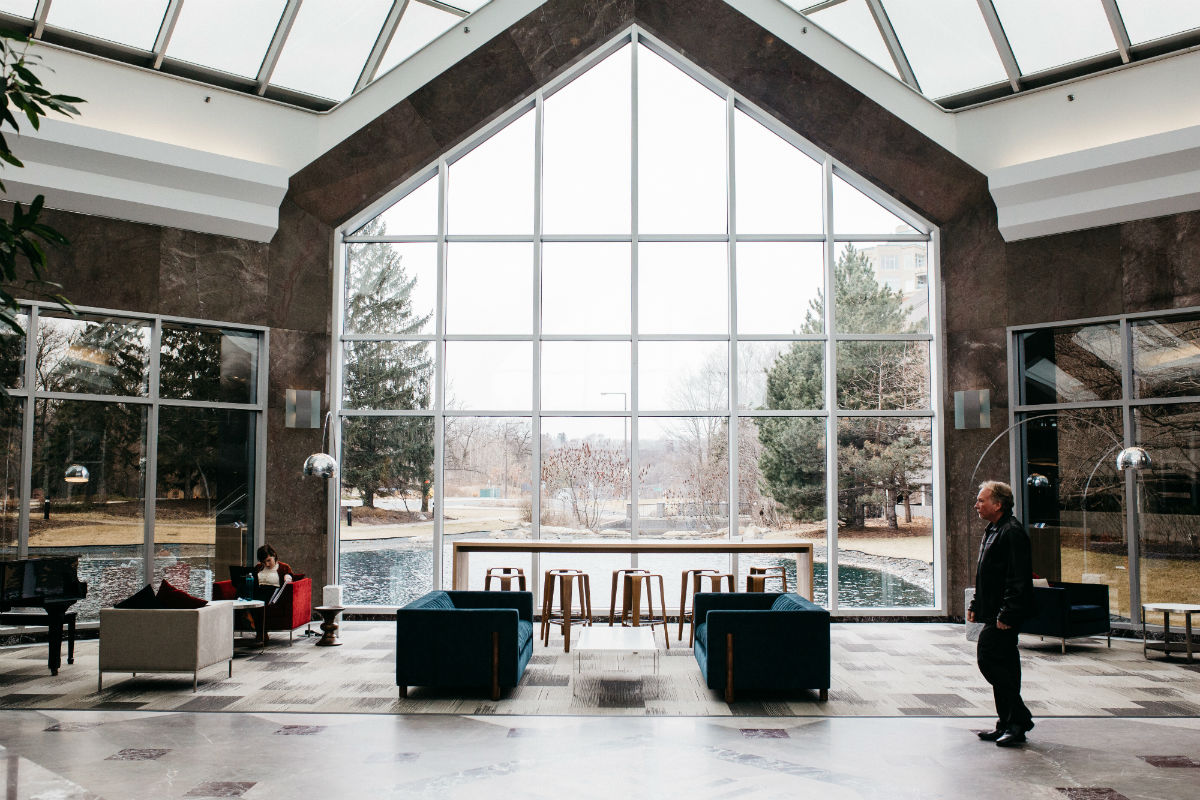At Shea, we pride ourselves on staying on top of what’s happening in design news. It helps us keep tabs on what’s fresh, inspiring, and happening in the world—and we make a few headlines of our own, too. Here are some recent articles delving into design, experience, and what’s buzzing in our community:
“The Suburban Office Park Rises From the Dead” – Fast Company:
This Fast Company piece explores the resurgence of the suburban office park, where developers essentially build neighborhoods centered around an office building or campus—a revival influenced by the amenity-rich tech campuses that have cropped up. They offer workers the amenities that they’re craving, especially post-pandemic, with plenty of space and nature around them. The story explores the history of office parks from the 1950s on, including the fade of suburban offices in the 2000s and how they’re becoming livelier and more flexible for today’s workforce. Office-park redevelopments are expensive, but a big draw for companies as they start to spread out more from urban cores and provide everything that tenants could want.
“A Forward-Looking Design Firm: How Shea Makes is Innovating the Future of Design” – Shea:
The latest How We Create piece going behind the scenes at Shea, highlighting Shea Makes and the team’s custom work
“5 Trends Impacting Serveries” – Foodservice Equipment & Supplies:
Foodservice Equipment & Supplies takes a look at how servery design is being impacted today, particularly in educational facilities, airports, and corporate settings. Labor issues are hot right now, and serveries are working around them with layout solutions like stations that can be closed off when not in use. Hybrid offices will impact corporate serveries, pushing them towards digital preorders so that they’re not wasting labor and food resources on employees not in the office. Consumers want flexibility from their serveries, so stations will need to be equipped to serve multiple functions. In hospitals and medical facilities, serveries need to be set up for fast delivery and takeout options, such as with food lockers and pickup areas. And some serveries are switching tactics completely, moving towards a “microrestaurant” model that’s more based on food-hall setups.
“Redefining Fine Dining” – Foodservice Equipment & Supplies:
Fine dining has long been shifting to the more casual side in terms of dress code and vibe, but post-pandemic, it’s getting another overhaul. Many restaurants refer to it as “finer dining” now, with high-quality service and food but without any pretension. The segment was hit hard by the pandemic, and between supply-chain issues, labor, and billings, finer-dining restaurants have had to adapt just like their more casual counterparts, with takeout, delivery, and meal kits. Exhibition cooking is starting to wane, as open kitchens are difficult when it comes to conversions and pivots and fire-based cooking and cooking technology for consistency’s sake are on the rise. Finally, fine-dining menus have benefitted from the locavore movement, and many are moving into the plant-based realm (a la premier dining institution Eleven Madison Park)—but still using the same kitchen equipment and tactics.
“The Trouble With Airports, and How to Fix Them” – New York Times:
Travel stress has reached a peak, and airport designers are working to combat that with calming spaces. American airports are behind in their improvements compared to global gateway cities, and this piece not only dives into the solutions, but also the reasons why (infrastructure funding is a major factor). One thing designers are working to do is to calm the airport noise, creating quiet spaces with reduced audio clutter. In keeping with other hospitality spaces, airports are also incorporating biophilia, particularly by adding outdoor spaces when possible, but also by bringing in natural materials and shapes. Airport design is also acknowledging human needs more than ever, with thoughtful areas for kids, as well as spots for anxious flyers to unwind. And they’re embracing locality, with iconic views of the surrounding areas and locally inspired artwork.
“Petite Leon and Vivir Lead the Way in Produce-Centric Plates” – Shea:
The Nation’s Restaurant News piece featuring Petite Leon and Vivir as leaders in the produce-centric-plate movement
“Hotel Restaurants Get Ready for a Rebound” – FSR:
The hotel industry is making up for lost time when it comes to dining post-pandemic, with many projects moving out of delays and brands kicking off new hotel eateries as guests release their pent-up demand for dining and travel. Kimpton, for example, is expanding many of its boutique-hotel restaurant programs to include several on-site concepts—a smart move, given that conversion rates among consumers are rising (so diners and becoming guests, and vice versa). Some hotels are adding consultants or in-brand restaurateurs to approach F&B programming from a fresh perspective, making the restaurants destinations in themselves. It’s about creating “a restaurant that happens to be in a hotel,” versus a “hotel restaurant,” and this story looks at how a handful of concepts across the country have embraced that notion. Another way to go is for hoteliers to take the strategy of partnering with known restaurateurs and operators to develop concepts in their spaces. This can be a win-win for both parties, since the restaurant can bring a special local flair while gaining a built-in customer base.
“Designing Welcoming Outdoor Spaces for the Return to the Office” – Work Design:
As offices begin to refill, everyone has an eye towards the way that workers interact with their environments, especially with regard to wellness—and this means in influx of terraces, patios, rooftops, and plazas that are equipped for work but also feature relaxation amenities. Creating comfortable spaces is vital, considering a balance of shady and sunny spots and utilizing nearby natural elements in the design. Weather-resistant areas that allow for electronic wiring and tech are important, as are recreational amenities like comfortable outdoor furniture, outdoor games, and outdoor seating for dining. Office buildings are going through a revolution, and their exteriors have become just as important as interior features when it comes to attraction, retention, and differentiation.
“Original Green Mill Reopens With a Fresh Face” – Shea:
The Star Tribune story on Shea’s Green Mill St. Paul renovation
“Restaurants Spend Big for Upgraded Outdoor Dining With Quicker Service, Elaborate Décor for Winter” – Wall Street Journal:
The WSJ dives deep into how restaurants are working to stay afloat through winter, especially given the issues (supply and labor shortages, specifically) they’re facing. Going all-in on an outdoor dining experience can be risky when it comes to pleasing the customer, and can be costly when it comes to creating a space where people want to be. However, things are significantly upgraded from last year, with restaurateurs looking towards sturdier physical structures and chicer solutions to keep diners warm. This story looks at several locations around the country experimenting with different options, whether they’re investing for the future or still going with a more economical route.
October 14, 2021
Shea Links: October

